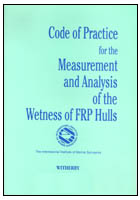제품상세보기
Nautical Publications
AND ANALSIS OF THE WETNESS OF FRP HULLS
Polyester is the most widely used resin in the manufacture of fibre reinforced plastic boats. It is not so suitable for marine use as epoxy resin but is considerably cheaper. All resins consist of a mixture of several substances, the molecules of which initially form short chemical chains called oligomers. As the resin cures these link up to form much longer chains called polymers which consitute the hardened plastic. Polyester resin basically consists of an acid mixed with an alcohol in combination with a solvent. It commonly contains about 25% to 40% unsaturated acid, usually maleic acid, and 75% to 60% of a saturated acid. The maleic acid is used to control the amount of cross linking in the finished plastic. For general purpose resins the saturated acid is usually ortho-phthalic acid (sometimes simply known as phthalic acid) but for boat building purposes in the laminate matrix iso-phthalic acid (sometimes known as meta-phthalic acid) is more commonly used. This latter acid has an increased resistance to water absorption and chemical attack but is slightly more expensive. The alcohol is usually propylene glycol. Sometimes a quantity of diethylene glycol is also added to reduce cost and to give the cured resin increaesed resilience. For the gel coat resins it is usual to use neopentyl glycol either alone or in combination with either or both of the other two glycols. The solvent used is styrene. This substance not only acts as a solvent but also takes an active part in the chemical reaction by which the resin cures. An inhibitor is also added. This is usually about 1% cobalt and is included to prevent the styrene reacting prematurely with the other components and to reduce the risk of the resin 'age-hardening' whilst in storage. This inhibitor also helps to start the curing process at lower temperatures than would otherwise be needed. To start the reaction by which the resin cures about 1.2% to 2% of an initiator catalyst methyl ethyl ketone peroxide (MEKP) is also added.





